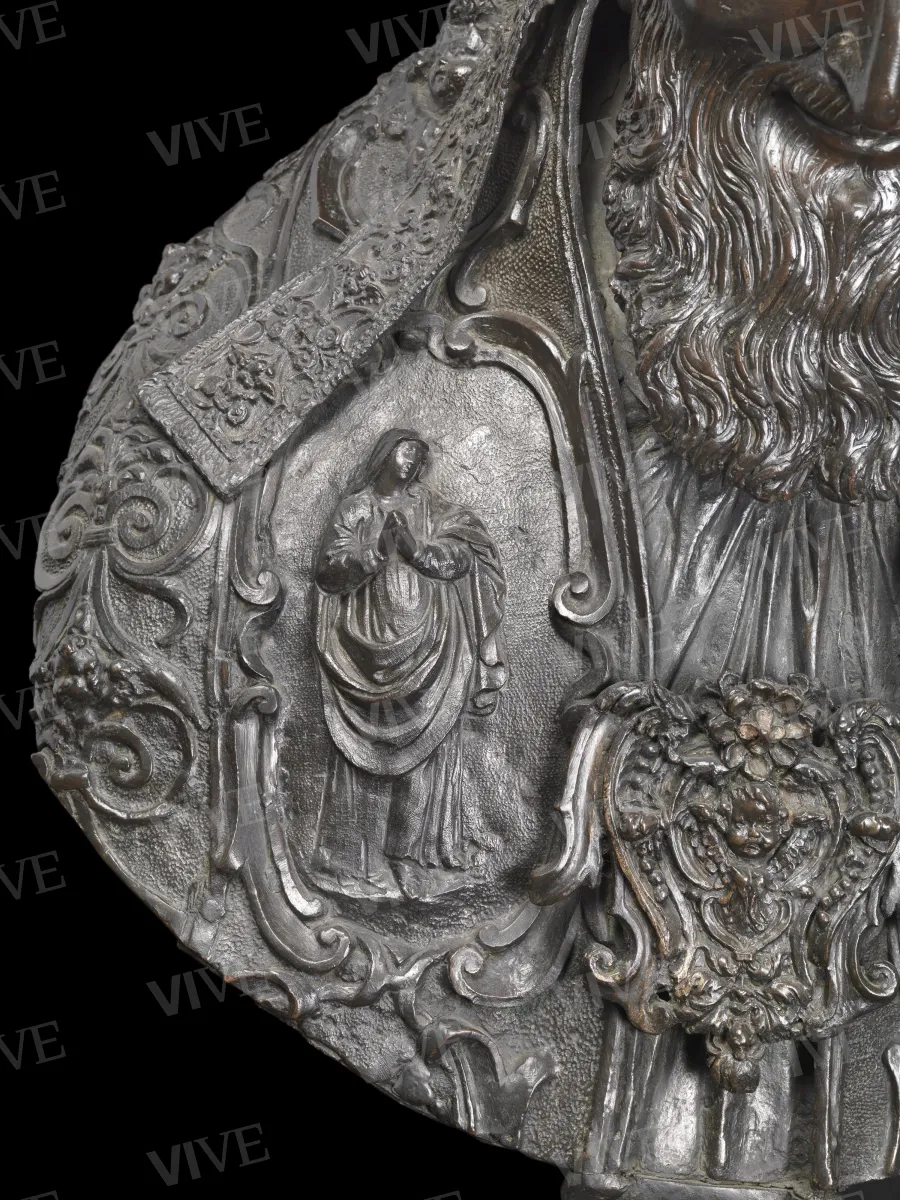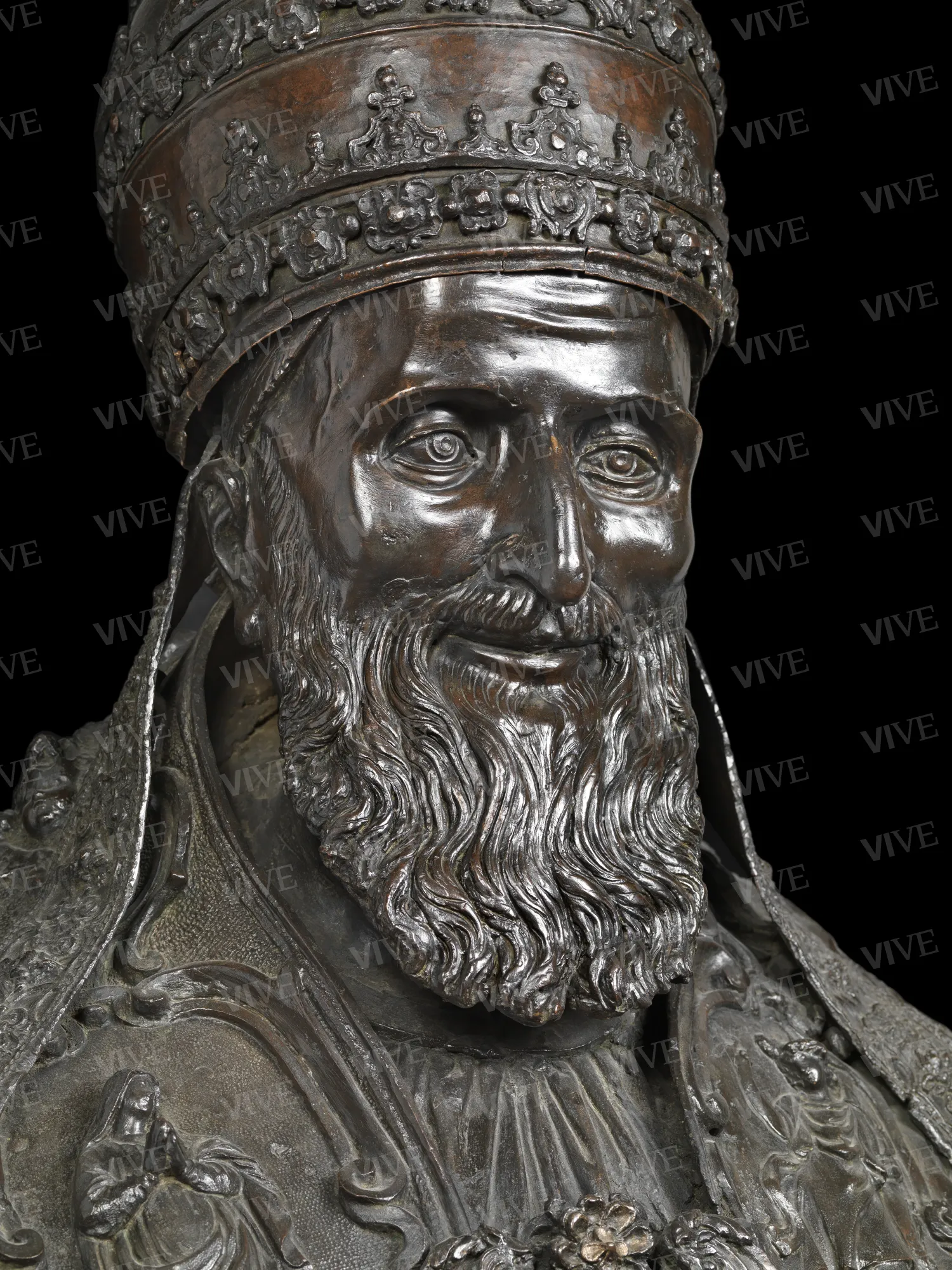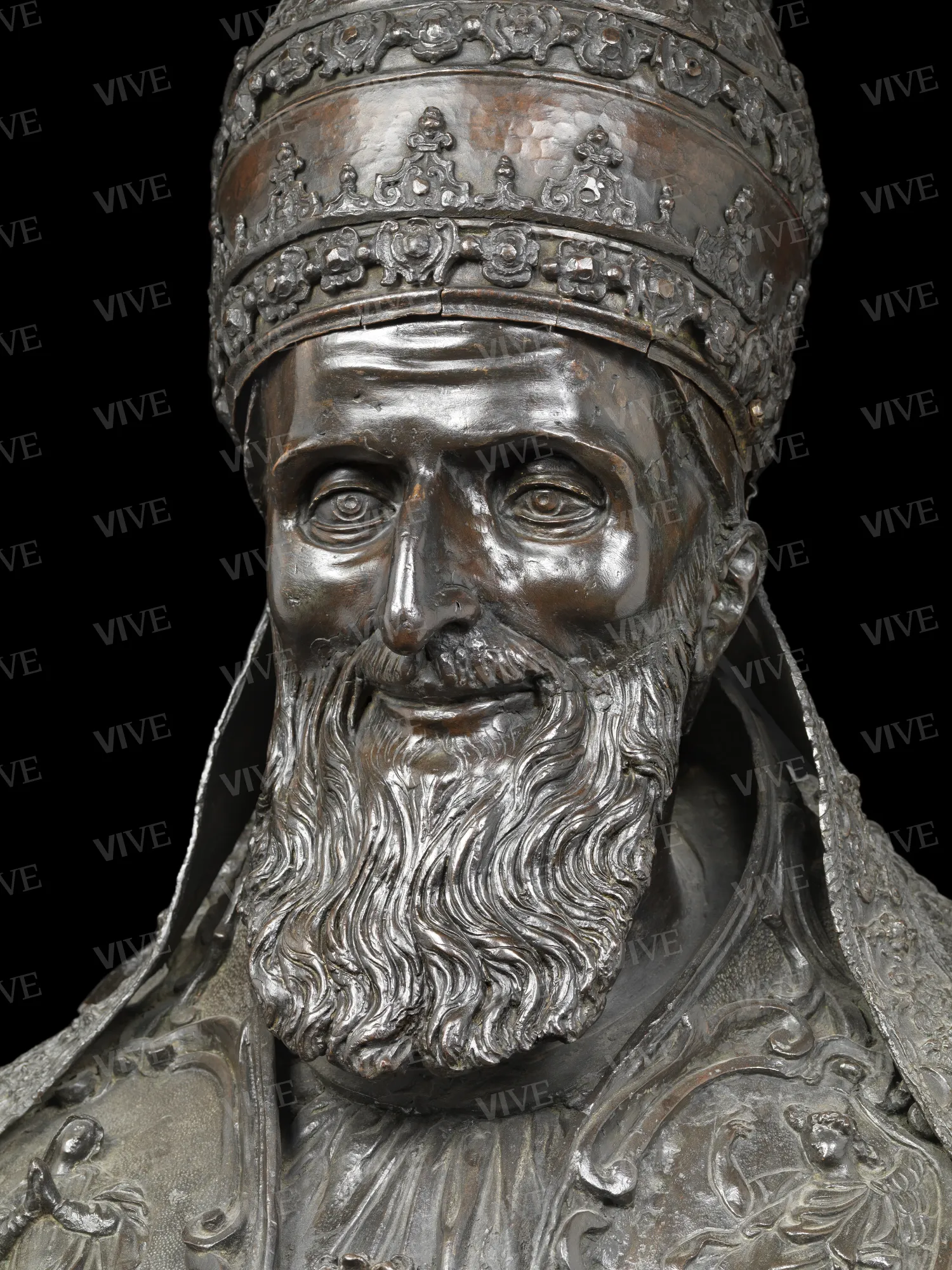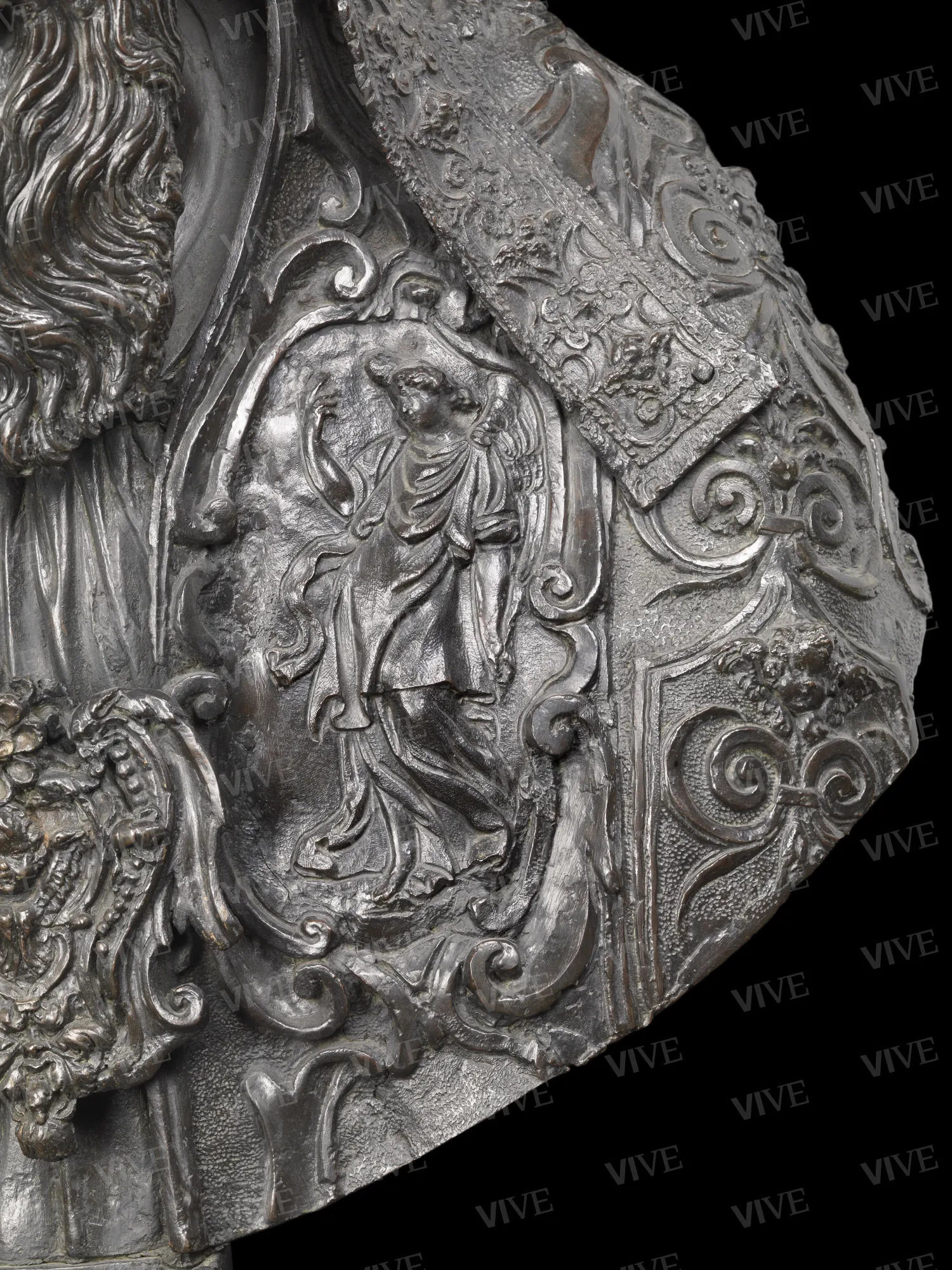Bust of Pope Pius V
Milieu Guglielmo Della Porta C. 1570
The bronze bust depicts Pius V (born Antonio Ghislieri, Bosco Marengo 1504–Rome 1572) and is the only bronze portrait of Pope Ghislieri, who served from 1566 until his death. Its unique nature makes it difficult to attribute with certainty, with attributions ranging from Sebastiano Torrigiani to an unidentified sculptor active in Rome during the 1570s. The vividness of this bust compared to posthumous portraits suggests a date around 1570 and implies that the creator might be among artists associated with Guglielmo Della Porta.
The bronze bust depicts Pius V (born Antonio Ghislieri, Bosco Marengo 1504–Rome 1572) and is the only bronze portrait of Pope Ghislieri, who served from 1566 until his death. Its unique nature makes it difficult to attribute with certainty, with attributions ranging from Sebastiano Torrigiani to an unidentified sculptor active in Rome during the 1570s. The vividness of this bust compared to posthumous portraits suggests a date around 1570 and implies that the creator might be among artists associated with Guglielmo Della Porta.
Details of work
Catalog entry
The partially gilded bronze bust, as evidenced by traces of gilding on the clasp and forehead (Bacchi, 2019), portrays Pope Pius V. He is adorned with a tiara and an exquisite cope decorated with candelabra, cherubs, and raised mixtilinear frames surrounding the figures of the announcing angel and the Virgin Mary. The two edges of the mantle are secured by a detailed clasp, flanked by fantastical creatures and completed at the bottom with a mask composed of leaves featuring a cherub at its center. The portrait is supported by a bronze pedestal, which features decorations at the corners including two cherubs framing the Ghislieri coat of arms. This coat of arms is placed in the center and is topped with a decorative head along with the papal symbols of the tiara and keys. The lower part of the coat of arms forms the eyebrows of another mask that extends downwards, with the inscription “PIVS • V • O • M •”. The sides of the base are adorned with a pattern of plant racemes. The work was acquired by the Museo Nazionale di Palazzo Venezia in 2020 after experiencing significant challenges in the market (Melograni 2021). It was largely unknown before its appearance in New York in 2000 at a Sotheby’s auction (Sotheby’s New York, January 26–27, 2000), which indicated several changes in ownership from the collection of King Leopold I of Belgium to that of the Duke of Flanders, though these changes are unconfirmed (Melograni 2021, 264, n. 1). There are no other known bronze portrait busts of Pius V, and the only existing sculptural representations include two posthumous portraits by Leonardo Sormani (the statue in Santa Maria Maggiore and the marble bust in Perugia, Galleria Nazionale dell’Umbria) and the effigy by Antonio Buzzi in the relief depicting the Resurrection of Christ in the papal cenotaph in Santa Croce in Bosco Marengo (based on a design by Guglielmo Della Porta). The bust is indeed distinctive. Initially attributed to Sebastiano Torrigiani in the aforementioned New York auction, its classification was revised by Andrea Bacchi (2019), who reassigned it to the renowned “great school” of Guglielmo Della Porta (Baglione [1642] 2023). Bacchi further adjusted the chronology to the early 1570s, coinciding with the period when the pope was still alive. The composition of Pius V is notably distinct, differing significantly from the well-known portraits of the pope, such as Torrigiani’s busts (e.g., Sixtus V in Treia). It bears a closer resemblance to the models of La Porta from the Farnese years (e.g., the portraits of Paul III in Capodimonte). The presence of whimsical and fantastical elements in the coat of arms and fibula aligns it with the style of Guglielmo Della Porta, and the surface treatment demonstrates meticulous craftsmanship. Specifically, the background surfaces of the cope feature fine chiseling similar to that used by Cesare Targone, which can be seen in works such as the Lamentation of the Virgin over the Body of Christ (Los Angeles, Getty Museum, inv. 84.SE.121) and the Banquet of the Gods (New York, Metropolitan Museum, inv. 12.135.5), potentially cast by Antonio Gentili after a model by Guglielmo Della Porta. The bust’s abundant decorative elements, especially vegetal motifs, distinguish it significantly. Its ornamentation aligns more closely with Lombard figurative culture than with Roman styles. The presence of an unpublished bust of Sixtus V in the Lateran Palace, which mirrors the form of the one in Palazzo Venezia but differs in casting and craftsmanship, indicates a Roman origin for the portrait of Pius V. This origin is likely tied to one of the many masters—including some from northern Italy—associated with Guglielmo Della Porta’s workshop during his pontificate.
Clara Seghesio
Entry published on 12 June 2025
State of conservation
Good.
Restorations and analyses
2018: analysis by the Art-Test company under the supervision of the Opificio delle Pietre Dure; 2019: restoration by Ludovica Nicolai.
Inscriptions
“PIVS • V P • O • M •.”
Provenance
Bolsena, Palazzo del Drago di Bolsena, purchased in New York, Sotheby’s auction, January 26–27, 2000;
Rome, Museo Nazionale di Palazzo Venezia, purchased in 2020.
References
Sotheby’s New York, 26-27 January 2000, European Works of Art, Tapestries and Furniture: English Furniture and Decorations. Including Property of The Art Institute of Chicago, pp. 44-45, lotto 69;
Prosperi Valenti Rodinò Simonetta, "Officina farnesiana": disegni per oreficerie, in Mogbeig-Goguel Catherine, Costamagna Philippe (a cura di), Francesco Salviati et la Bella Maniera, Actes del colloques de Rome et de Paris (1998), Rome 2001, pp. 405-428;
Bacchi Andrea, Roma 1570. Un busto in bronzo di Pio V, Milano 2019;
Melograni Anna, L’acquisto e il restauro del busto in bronzo di Pio V Ghislieri per il Museo Nazionale di Palazzo Venezia, in «Bollettino d’arte», 47/48, 2021, pp. 257-266;
Baglione Giovanni, Le vite de’ pittori, scultori et architetti. Dal pontificato di Gregorio XIII del 1572. In fino a’ tempi di Papa Urbano Ottavo nel 1642 [Roma 1642], a cura di Agosti Barbara, Tosini Patrizia, Roma 2023, 2 voll., I, p. 648.




















